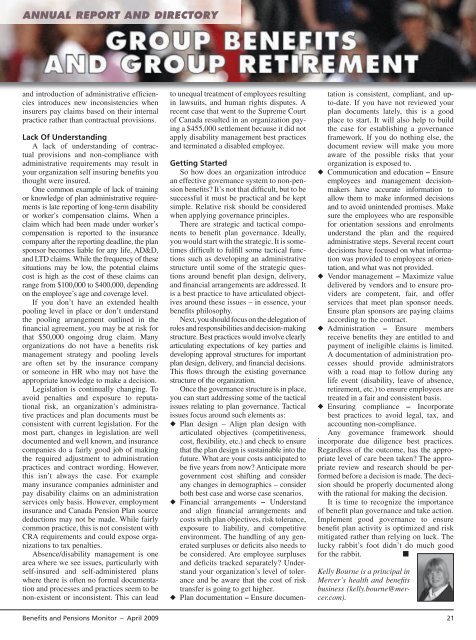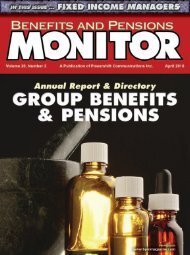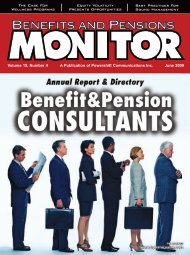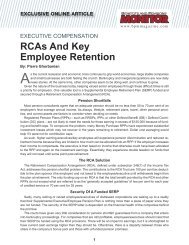April - Benefits and Pensions Monitor
April - Benefits and Pensions Monitor
April - Benefits and Pensions Monitor
Create successful ePaper yourself
Turn your PDF publications into a flip-book with our unique Google optimized e-Paper software.
ANNUAL REPORT AND DIRECTORY<br />
<strong>and</strong> introduction of administrative efficiencies<br />
introduces new inconsistencies when<br />
insurers pay claims based on their internal<br />
practice rather than contractual provisions.<br />
Lack Of Underst<strong>and</strong>ing<br />
A lack of underst<strong>and</strong>ing of contractual<br />
provisions <strong>and</strong> non-compliance with<br />
administrative requirements may result in<br />
your organization self insuring benefits you<br />
thought were insured.<br />
One common example of lack of training<br />
or knowledge of plan administrative requirements<br />
is late reporting of long-term disability<br />
or worker’s compensation claims. When a<br />
claim which had been made under worker’s<br />
compensation is reported to the insurance<br />
company after the reporting deadline, the plan<br />
sponsor becomes liable for any life, AD&D,<br />
<strong>and</strong> LTD claims. While the frequency of these<br />
situations may be low, the potential claims<br />
cost is high as the cost of these claims can<br />
range from $100,000 to $400,000, depending<br />
on the employee’s age <strong>and</strong> coverage level.<br />
If you don’t have an extended health<br />
pooling level in place or don’t underst<strong>and</strong><br />
the pooling arrangement outlined in the<br />
financial agreement, you may be at risk for<br />
that $50,000 ongoing drug claim. Many<br />
organizations do not have a benefits risk<br />
management strategy <strong>and</strong> pooling levels<br />
are often set by the insurance company<br />
or someone in HR who may not have the<br />
appropriate knowledge to make a decision.<br />
Legislation is continually changing. To<br />
avoid penalties <strong>and</strong> exposure to reputational<br />
risk, an organization’s administrative<br />
practices <strong>and</strong> plan documents must be<br />
consistent with current legislation. For the<br />
most part, changes in legislation are well<br />
documented <strong>and</strong> well known, <strong>and</strong> insurance<br />
companies do a fairly good job of making<br />
the required adjustment to administration<br />
practices <strong>and</strong> contract wording. However,<br />
this isn’t always the case. For example<br />
many insurance companies administer <strong>and</strong><br />
pay disability claims on an administration<br />
services only basis. However, employment<br />
insurance <strong>and</strong> Canada Pension Plan source<br />
deductions may not be made. While fairly<br />
common practice, this is not consistent with<br />
CRA requirements <strong>and</strong> could expose organizations<br />
to tax penalties.<br />
Absence/disability management is one<br />
area where we see issues, particularly with<br />
self-insured <strong>and</strong> self-administered plans<br />
where there is often no formal documentation<br />
<strong>and</strong> processes <strong>and</strong> practices seem to be<br />
non-existent or inconsistent. This can lead<br />
to unequal treatment of employees resulting<br />
in lawsuits, <strong>and</strong> human rights disputes. A<br />
recent case that went to the Supreme Court<br />
of Canada resulted in an organization paying<br />
a $455,000 settlement because it did not<br />
apply disability management best practices<br />
<strong>and</strong> terminated a disabled employee.<br />
Getting Started<br />
So how does an organization introduce<br />
an effective governance system to non-pension<br />
benefits? It’s not that difficult, but to be<br />
successful it must be practical <strong>and</strong> be kept<br />
simple. Relative risk should be considered<br />
when applying governance principles.<br />
There are strategic <strong>and</strong> tactical components<br />
to benefit plan governance. Ideally,<br />
you would start with the strategic. It is sometimes<br />
difficult to fulfill some tactical functions<br />
such as developing an administrative<br />
structure until some of the strategic questions<br />
around benefit plan design, delivery,<br />
<strong>and</strong> financial arrangements are addressed. It<br />
is a best practice to have articulated objectives<br />
around these issues – in essence, your<br />
benefits philosophy.<br />
Next, you should focus on the delegation of<br />
roles <strong>and</strong> responsibilities <strong>and</strong> decision-making<br />
structure. Best practices would involve clearly<br />
articulating expectations of key parties <strong>and</strong><br />
developing approval structures for important<br />
plan design, delivery, <strong>and</strong> financial decisions.<br />
This flows through the existing governance<br />
structure of the organization.<br />
Once the governance structure is in place,<br />
you can start addressing some of the tactical<br />
issues relating to plan governance. Tactical<br />
issues focus around such elements as:<br />
◆ Plan design – Align plan design with<br />
articulated objectives (competitiveness,<br />
cost, flexibility, etc.) <strong>and</strong> check to ensure<br />
that the plan design is sustainable into the<br />
future. What are your costs anticipated to<br />
be five years from now? Anticipate more<br />
government cost shifting <strong>and</strong> consider<br />
any changes in demographics – consider<br />
both best case <strong>and</strong> worse case scenarios.<br />
◆ Financial arrangements – Underst<strong>and</strong><br />
<strong>and</strong> align financial arrangements <strong>and</strong><br />
costs with plan objectives, risk tolerance,<br />
exposure to liability, <strong>and</strong> competitive<br />
environment. The h<strong>and</strong>ling of any generated<br />
surpluses or deficits also needs to<br />
be considered. Are employee surpluses<br />
<strong>and</strong> deficits tracked separately? Underst<strong>and</strong><br />
your organization’s level of tolerance<br />
<strong>and</strong> be aware that the cost of risk<br />
transfer is going to get higher.<br />
◆ Plan documentation – Ensure documentation<br />
is consistent, compliant, <strong>and</strong> upto-date.<br />
If you have not reviewed your<br />
plan documents lately, this is a good<br />
place to start. It will also help to build<br />
the case for establishing a governance<br />
framework. If you do nothing else, the<br />
document review will make you more<br />
aware of the possible risks that your<br />
organization is exposed to.<br />
◆ Communication <strong>and</strong> education – Ensure<br />
employees <strong>and</strong> management decisionmakers<br />
have accurate information to<br />
allow them to make informed decisions<br />
<strong>and</strong> to avoid unintended promises. Make<br />
sure the employees who are responsible<br />
for orientation sessions <strong>and</strong> enrolments<br />
underst<strong>and</strong> the plan <strong>and</strong> the required<br />
administrative steps. Several recent court<br />
decisions have focused on what information<br />
was provided to employees at orientation,<br />
<strong>and</strong> what was not provided.<br />
◆ Vendor management – Maximize value<br />
delivered by vendors <strong>and</strong> to ensure providers<br />
are competent, fair, <strong>and</strong> offer<br />
services that meet plan sponsor needs.<br />
Ensure plan sponsors are paying claims<br />
according to the contract.<br />
◆ Administration – Ensure members<br />
receive benefits they are entitled to <strong>and</strong><br />
payment of ineligible claims is limited.<br />
A documentation of administration processes<br />
should provide administrators<br />
with a road map to follow during any<br />
life event (disability, leave of absence,<br />
retirement, etc.) to ensure employees are<br />
treated in a fair <strong>and</strong> consistent basis.<br />
◆ Ensuring compliance – Incorporate<br />
best practices to avoid legal, tax, <strong>and</strong><br />
accounting non-compliance.<br />
Any governance framework should<br />
incorporate due diligence best practices.<br />
Regardless of the outcome, has the appropriate<br />
level of care been taken? The appropriate<br />
review <strong>and</strong> research should be performed<br />
before a decision is made. The decision<br />
should be properly documented along<br />
with the rational for making the decision.<br />
It is time to recognize the importance<br />
of benefit plan governance <strong>and</strong> take action.<br />
Implement good governance to ensure<br />
benefit plan activity is optimized <strong>and</strong> risk<br />
mitigated rather than relying on luck. The<br />
lucky rabbit’s foot didn’t do much good<br />
for the rabbit.<br />
■<br />
Kelly Bourne is a principal in<br />
Mercer’s health <strong>and</strong> benefi ts<br />
business (kelly.bourne@mercer.com).<br />
<strong>Benefits</strong> <strong>and</strong> <strong>Pensions</strong> <strong>Monitor</strong> – <strong>April</strong> 2009<br />
21









